IceCube: giant frozen neutrino detector

IceCube is one of the largest experiments in the world. It consists of a cubic kilometer (almost a billion tons) of ice, located deep beneath the snowy surface of the southern pole of our planet. It is designed to detect neutrinos from deep space that can collide with something inside, or in close proximity to this clump. In this article I will talk a little about how it works.
Elusive neutrinos
To understand the motivation of this experiment, it would be nice to start with a small review of the neutrino. There are three types of them, as well as three types of antineutrinos, but for now, instead of discussing their differences, let's concentrate on what they have in common.
I will not write “neutrino and antineutrino” every time. IceCube does not distinguish between neutrinos and antineutrinos, so unless otherwise indicated, I will simply call them “neutrinos”. The same is true for muons, by which I will mean muons and anti-muons.
The main thing that all neutrinos have in common (as opposed to electrons and positrons and quarks and antiquarks and photons and most other known particles) - neither electromagnetic interaction nor strong nuclear interaction affects them. They are affected only by a weak nuclear interaction. But it is so weak that neutrinos easily pass through huge volumes of ordinary matter. This distinguishes them from electrons, photons, protons, neutrons and other hadrons. In fact, trillions of neutrinos pass through your body every second - this fact became known to us only a few decades ago. Since all people's attempts to detect a neutrino (or something else) boil down to building some kind of device consisting of ordinary matter, the fact that neutrinos pass ordinary matter through, leaving no trace, is rather inconvenient for anyone who would like to observe them.
Think about how it would be inconvenient if photons passed right through our photon detectors (those things on the face that we call “eyes”) without any trace! Of course, because of this, we have eyes for detecting photons, but no eyes for detecting neutrinos — such eyes would be useless.
But although the part of neutrinos that manage to crash into something when passing through matter is very small, it is not zero, so in principle we can detect them. But it turns out that we have no choice but to:
• get a large piece of material that stops neutrinos;
• locate around and within it scientific instruments;
• wait.
Scientists have to play the role of a patient spider with a very large web, or a silent fisherman with a huge network, and wait for a rare neutrino that flies without dismantling the road, suddenly finds itself in a trap.
And here comes the IceCube case.
IceCube: billion tons of ice
IceCube is science fiction that has become a reality. This is a giant ice cube - clean, free of bubbles and almost perfectly transparent. On our planet, such gigantic volumes of perfect ice can be found only on plains close to the south pole, deep below the surface. And in this ice, scientists bite on two and a half kilometers, not using anything more clever than hot water. As shown in fig. 1, in each hole (half a meter wide), scientists placed a long string, the bottom kilometer of which is littered with sixty evenly spaced photo cells capable of detecting the smallest flashes of light. Below, at a depth of a thousand meters in the ice, it is very dark. Light from the surface of the earth does not penetrate to such a depth. So everything that a photocell can detect in pitch darkness should be something special.
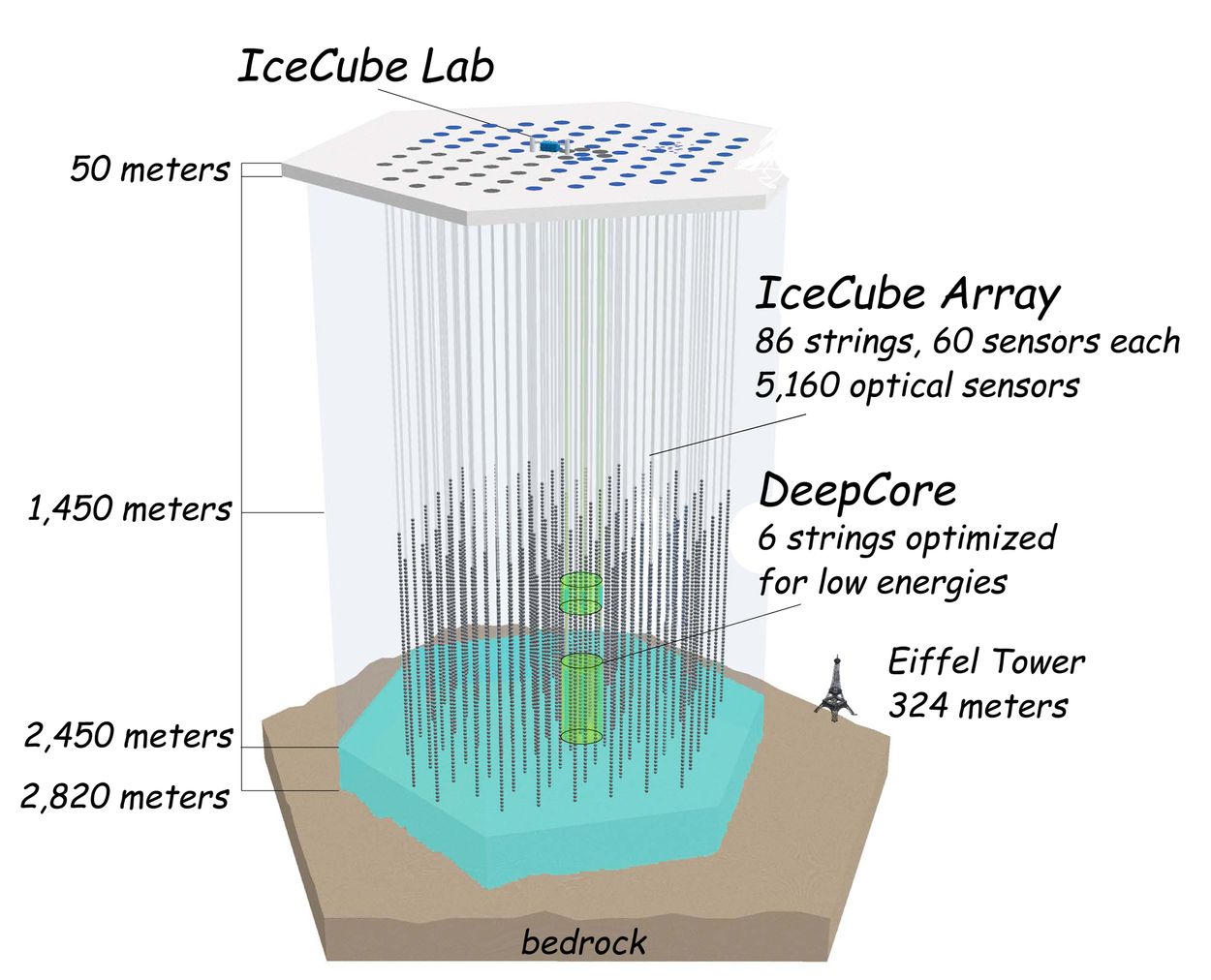
Fig. one
What kind of light source could be inside a lifeless block of clear ice? The only source is particle physics. When an elementary particle that carries a lot of energy penetrates the IceCube and hits the nucleus of an atom in ice, it creates a cascade of particles moving at almost the speed of light c - slower than light in a vacuum, but faster than light in ice. Electrically charged particles moving faster than the speed of light in the material emit a dim cone of light, Cherenkov radiation (the essence here is almost the same as that of a supersonic aircraft emitting a loud pop). Although this light is dim, it can go through many meters of ice and can be detected with photo cells. And the way this light spread can tell scientists:
• approximately how much energy was given to ice, taking into account the approximate estimate of the energy transferred by the particle;
• where the particle came from;
• information on the type of particle colliding with the nucleus and on the type of collision.
This is shown in fig. 2, where two neutrinos arrive from the sky, one of which generates a cascade of particles in which no high energy muon is produced, and the other generates a cascade in which a high energy muon is formed. The latter can occur when a flying neutrino is a muon neutrino, which a weak interaction during a collision can turn into a muon. The same is shown in fig. 3 for neutrinos arriving from the other side of the Earth, which, from the point of view of the IceCube, are flying out of the earth.
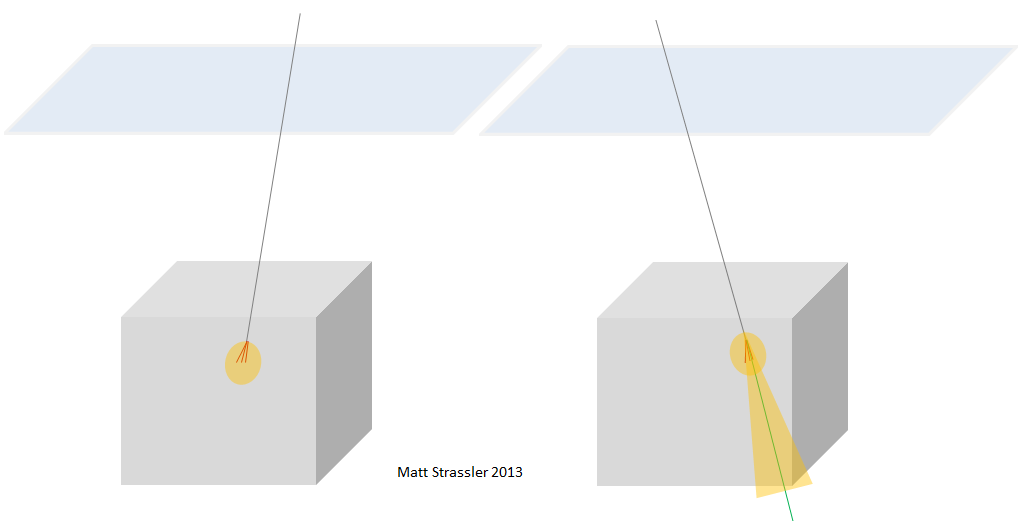
Fig. 2
The only type of particles that can pass through a kilometer of ice, or even a large part of the Earth, is neutrinos and muons. Therefore, to detect the IceCube neutrino, you only need to make sure that it can distinguish their effect from the effects of muons. Partially this process is shown in fig. 6, where it can be seen that the incoming muon gives light at the entrance to the IceCube, but does not give a neutrino.
That's the whole icecube. Almost. It is also necessary to mention a few photocells located on the ice surface, in the IceTop cluster. Their purpose will become clear when we get to rice. 7. And yet, compared to the detectors of the Large Hadron Collider, which are much smaller than the IceCube, this is a very simple detector.
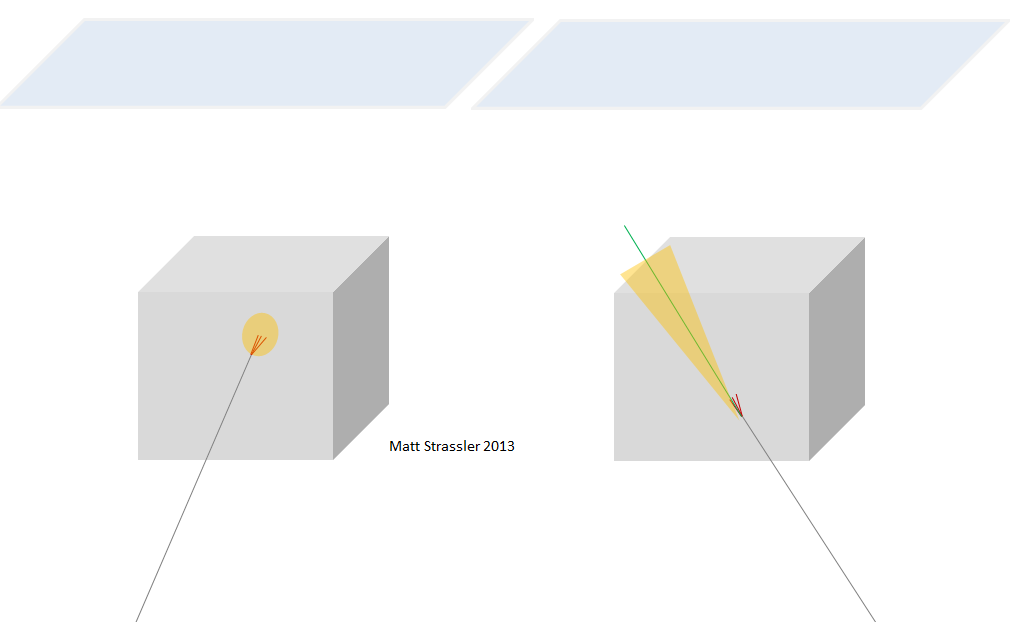
Fig. 3
The technology used in the IceCube was tested on a piece of ice ten times smaller in the AMANDA experiment. The same idea (using Cherenkov radiation due to neutrino-matter collisions) was used in large water tanks instead of ice. But you understand that a water tank the size of an IceCube is not easy to organize. The only way to get so much water is to use the ocean, this is exactly what ANTARES experiment does, placing instruments on the strings at a great depth [ in fact, not - there is still such a unique lake as Baikal, in which the same detector is being prepared waters: Baikal Underwater Neutrino Telescope // approx. trans. ]. There are drawbacks to ice - after the photocells are placed in the holes with water, and they are frozen, they cannot be obtained for repair in the event of a breakdown. On the other hand, there are currents in the ocean that will chatter your sensors, as well as a multitude of beings emitting light that will distract you from what you are trying to see. In any case, it’s good to have several experiments using different methods to compare the results and decide which aspects you can trust.
What IceCube is now seeing and can see
What natural processes generate neutrinos and antineutrinos that IceCube can detect? It can detect and measure neutrinos with energies in excess of 100 GeV - on the order of the mass energy (E = mc 2 ) of the Higgs particle. What is this neutrino?
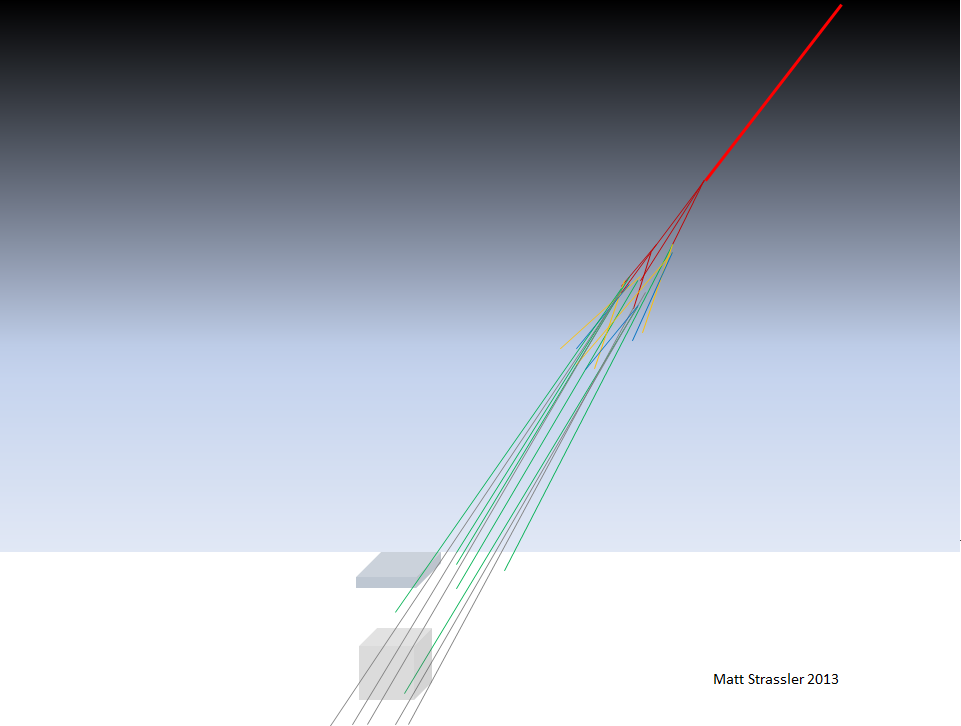
Fig. four
Some IceCube neutrinos will not detect: the more common low-energy neutrinos emanating from decays of unstable atomic nuclei in the rock (an example of radioactivity), neutrinos coming from the solar internal furnace, and neutrinos from supernova explosions. With these neutrinos, the energies reach from a few thousandths to a few hundredths of a GeV - this is far below the threshold required for effective detection on the IceCube.
The most common neutrino observed by the IceCube is atmospheric. They actually appear in the atmosphere of the earth due to cosmic rays. Cosmic rays are particles of very high energies, usually protons crashing into atomic nuclei in the upper layers of the atmosphere, and generating a cascade of hadrons (so called particles consisting of quarks, antiquarks and gluons), as well as photons, electrons and positrons. In turn, some of these hadrons can produce neutrinos during decay. These neutrinos have a wide range of energies, and the number of neutrinos decreases rapidly with increasing energy. They can come from all over the Earth, as shown in Fig. 5. Cosmic rays come from all directions, and collide with the atmosphere of the Earth in all places above its surface, therefore, neutrinos may appear, reaching IceCube from any point on the Earth's surface. An interesting geometric fact: IceCube (and any similar detector) gets an equal number of neutrinos from all directions - although those that came from the ground (that is, in the case of IceCube, from the north), pass thousands of kilometers through a stone, and those that came from above, pass through only 1-2 kilometers of ice.

Fig. five
Measuring neutrinos from above is quite problematic. Neutrinos and muons are very often found in atmospheric cascades, but muons are much more likely to give a signal to the IceCube than neutrinos, so much of what IceCube sees from coming from above is due to muons, not neutrinos. Most of the time, the signal clearly belongs to the muon, not the neutrino (Fig. 6), but sometimes something strange happens, and the light that distinguishes the muon from the neutrino is not detected. In this case, IceCube will produce the measurement of “false neutrino,” which was actually a muon. And although this is rare, so many muons are recorded that false neutrinos need to be monitored, especially for low energies.
Fortunately, most of the cosmic-ray muons do not make their way into the 1.5-km thick ice. Even better, muons emerging from cosmic rays beyond the horizon of the south pole need to travel hundreds or thousands of kilometers through the Earth to get into the IceCube - and they fail. Therefore, although muons are capable of creating false neutrinos going down (to the center of the Earth), they cannot create false neutrinos going up. Therefore, the signals going up are clean and almost always come from real neutrinos.
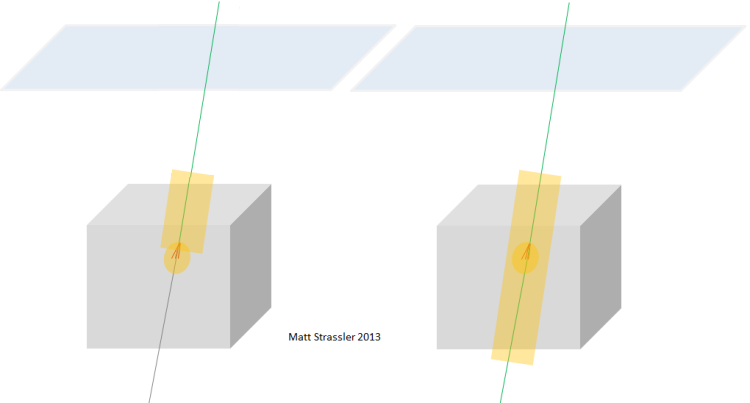
Fig. 6: Cosmic rays produce muons, some of which reach the IceCube. But unlike neutrinos, muons carry with them Cherenkov radiation. And the majority of muons can not pass through the thickness of the Earth, and therefore can not come from below
What about the rest of the neutrinos? Those that IceCube will most likely detect that they are its main target are called astrophysical neutrinos. What is it? We are quite sure, although we do not fully understand this, that something very striking is happening in space that gives rise to the cosmic rays of the highest energies. These are protons and atomic nuclei with energies approaching a million million GeV, and probably exceeding this threshold (Recall that the Large Hadron Collider accelerates protons to energies of several thousand GeV). It is almost impossible to imagine how this process of acceleration could have happened if in this far-away natural particle accelerator there were no collisions of protons and other matter. All these collisions should create neutrinos, with an energy lower than that of ultrahigh-energy cosmic rays, but still greater than we have seen before. We do not know how many such neutrinos are in space, but we have reason to believe that there are enough of them so that we can detect them on the IceCube. Perhaps we have already found them.
The main goal of IceCube is to detect astrophysical neutrinos and help find out where they come from. To do this, it is necessary not only to observe the neutrino, but also to look with the help of both ordinary and exotic telescopes, photons (visible light, radio waves, gamma rays - for anything!) Emanating from the same place in the sky, and perhaps at the same, or almost at the same time. For example, if somewhere in space an explosion of large force creates strong magnetic and electric fields that can accelerate protons and electrons to extreme energies, various interactions between these protons, electrons and the gas present there can generate both high-energy photons and high-energy astrophysical neutrino. If you're lucky, these photons can be detected with one of the special telescopes around the same time and from the same direction from which the IceCube detects neutrinos. (Yes, at any time there is a chance that we will detect only one astrophysical neutrino). This has not happened yet, to everyone’s disappointment, but IceCube has been working not so long ago.
In any case, the goal is that IceCube will see astrophysical neutrinos, it will become for us the same telescope as others, and will allow us to observe, albeit with such blurred neutrino vision, in which places the sky is “bright” due to high-energy neutrinos. Historically, each time a new telescope is introduced, we discover new objects in the sky, and we learn more about the objects we have already discovered. Therefore, with IceCube, there is hope that it will soon become a neutrino telescope, not tracking cosmic rays crashing into the atmosphere, but behind extremely energetic objects in deep space.
Look down and up
Atmospheric neutrinos come to us from above, and with them come muons, some of which generate the effect of a false neutrino. With an increase in energy, their number decreases, therefore, sufficiently high-energy astrophysical neutrinos (with energies approaching a million GeV) can be observed without interference. But astrophysical neutrinos with energies much less than one million GeV are lost in the sea of atmospheric neutrinos. Fortunately, there is a focus on reducing the number of atmospheric neutrinos and atmospheric muons coming from above, allowing IceCube to detect astrophysical neutrinos coming from above, with energies up to 10,000 GeV. This technique was used to obtain very interesting data. The two high-energy neutrinos in this data had such high energy that they were hardly atmospheric. But the remaining 26 (of which only 10 were expected) were spotted only after using this focus.
It consists in throwing down neutrinos, the nature of which is almost certainly atmospheric, and leaving only astrophysical neutrinos, some atmospheric and some false neutrinos generated by atmospheric muons. This cannot be done with 100% accuracy, but you can try, as shown in Fig. 7. Muons from the cosmic particle cascade (Fig. 4) arrive at IceTop (Fig. 1) at the same time as neutrinos arrive at the IceCube, up to a few hundred thousandths of a second. In this case, the neutrino is almost certainly atmospheric. Otherwise, probably not. Rejection almost certainly of atmospheric neutrinos greatly reduces their number, but scientists from IceCube claim that they still see more neutrinos than expected.

Fig. 7: atmospheric neutrinos reaching the detector usually go in the company of muons moving at the same time in the same direction. Some of the muons can be fixed on IceTop. Astrophysical neutrinos do not have such companions, so IceTop will not fix anything simultaneous.
All Articles